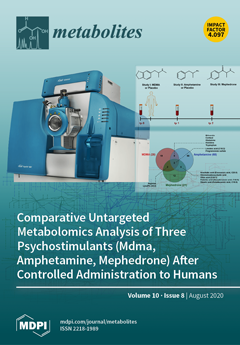Ascorbate (AsA) is required as a cofactor and is widely distributed in plants and animals. Recently, it has been suggested that the nematode
Caenorhabditis elegans also synthesizes AsA. However, its biosynthetic pathway is still unknown. To further understand AsA biosynthesis in
C. elegans
[...] Read more.
Ascorbate (AsA) is required as a cofactor and is widely distributed in plants and animals. Recently, it has been suggested that the nematode
Caenorhabditis elegans also synthesizes AsA. However, its biosynthetic pathway is still unknown. To further understand AsA biosynthesis in
C. elegans, we analyzed the incorporation of the
13C atom into AsA using gas chromatography-mass spectrometry (GC-MS) in worms fed with D-Glc (1-
13C)-labeled
Escherichia coli. GC-MS analysis revealed that AsA biosynthesis in
C. elegans, similarly to that in mammalian systems, involves carbon skeleton rearrangement. The addition of L-gulono-1,4-lactone, an AsA precursor in the mammalian pathway, significantly increased AsA level in
C. elegans, whereas the addition of L-galactono-1,4-lactone, an AsA precursor in the plant and
Euglena pathway, did not affect AsA level. The suppression of E03H4.3 (an ortholog of gluconolactonase) or the deficiency of F54D5.12 (an ortholog of L-gulono-1,4-lactone oxidase) significantly decreased AsA level in
C. elegans. Although N2- and AsA-deficient F54D5.12 knockout mutant worm (tm6671) morphologies and the ratio of collagen to non-collagen protein did not show any significant differences, the mutant worms exhibited increased malondialdehyde levels and reduced lifespan compared with the N2 worms. In conclusion, our findings indicate that the AsA biosynthetic pathway is similar in
C. elegans and mammals.
Full article






